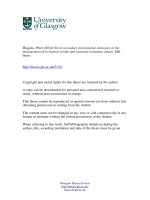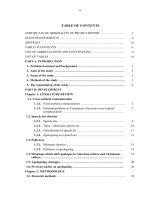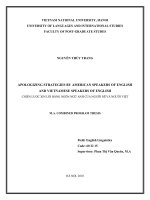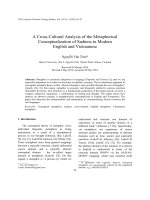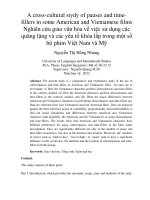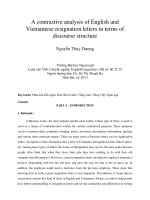Apologizing strategies by american speakers of english and vietnamese speakers of English
Bạn đang xem bản rút gọn của tài liệu. Xem và tải ngay bản đầy đủ của tài liệu tại đây (2.19 MB, 13 trang )
Apologizing strategies by american speakers of
english and vietnamese speakers of English
Nguyễn Thùy Trang
Trường Đại học Ngoại Ngữ
Luận văn ThS. Chuyên ngành: English Linguistics; Mã Số: 60 22 15
Người hướng dẫn: Phan Thị Vân Quyên, M.A
Năm bảo vệ: 2010
Abstract: The study “Apologizing strategies by American speakers of English and Vietnamese
speakers of English” is a cross-cultural pragmatics one concerning the production of apology
with reference to strategy preferences done via a written DCT and analyzed for sociocultural
features. Seventy-six informants equally falling into two main groups, American speakers of
English and Vietnamese speakers of English, were invited to participate in the survey from
which the apologizing verbal expressions towards different communicating partners in four
studied situations would be elicited. The exhaustive framework of apology strategies proposed
by Cohen and Olshtain (1989) and Trosborg (1995) were the foundation for this study whose
findings have revealed noticeable coincidences. Firstly, Vietnamese speakers of English and
American speakers of English both employed a same high level of using the strategy Explicit
expression of apology combining with Acknowledgment of responsibility and Explanation for the
violation when apologizing. It was however interesting that while the American subjects mainly
chose the strategy Offer of repair to apologize, the Vietnamese ones preferred to show Concern
for the hearer sharpening the images of the cultural traits of a sentimental Vietnamese culture
and a rational American culture. The Vietnamese’s apology realizations from this study
moreover reflect the more power and distance-sensitivity towards the selection of apologizing
strategies than the American groups, which has cemented the theories of Brown and Levinson
(1983), Trosborg (1989) and many other previous studies on the influential factors of the speech
act realization. The accomplishment of the thesis is hoped to serve as a useful source of reference
for researchers in related fields, Vietnamese teachers and learners of English as well as those
with regular Vietnamese – American cross-cultural contacts. Important findings have also
cemented the inevitability of incorporating culture into the teaching of English so that
Vietnamese learners of English will be provided with both linguistic and cultural input
Keywords: Tiếng Anh; Giao tiếp; Người Mĩ; Người Việt.
Content:
iv
TABLE OF CONTENTS
CERTIFICATE OF ORIGINALITY OF PROJECT REPORT
i
ACKNOWLEDGEMENTS
ii
ABSTRACT
iii
TABLE OF CONTENTS
iv
LIST OF ABBREVIATIONS AND CONVENTIONS
vi
LIST OF TABLES
vii
PART A: INTRODUCTION
1. Problem statement and background
2. Aims of the study
3. Scope of the study
4. Methods of the study
5. The organization of the study
PART B: DEVELOPMENT
Chapter 1: LITERATURE REVIEW
1.1. Cross-cultural communication
1.1.1. Cross-cultural communication
1.1.2. Potential problems in Vietnamese-American cross-cultural communication
1.2. Speech acts theories
1.2.1. Speech acts
1.2.2. Three – dimension speech act
1.2.3. Classification of speech act
1.2.4. Apologizing as a speech act
1.3. Politeness
1.3.1. Politeness theories
1.3.2. Politeness in apologizing
1.4. Situations which elicit apologies in American culture and Vietnamese culture
1.5. Apologizing strategies
1.6. Previous studies on apologizing
Chapter 2: METHODOLOGY
2.1. Research methods
2.2. Data collection instruments
2.3. The questionnaire
v
2.3.1. Factors manipulated in the DCT
2.3.2. The DCT
2.2. The subjects
2.3. Data collection procedure
Chapter 3: FINDINGS AND DISCUSSION
3.1. Overview of the apologizing strategies used by two groups of subjects
3.2. Choices of apologizing strategies by situations
3.2.1. Choices of strategies by Vietnamese speakers of English
3.2.2. Choices of strategies by American speakers of English
3.2.3. A comparison of the strategies preferences by two groups of subjects
3.3. Preferences of apologizing strategies as seen from communicating partner’s
parameters
3.3.1. Vietnamese’s apologizing strategies as seen from communicating partner’s
parameters
3.3.2. American’s apologizing strategies as seen from communicating partner’s
parameters
3.3.3. A comparison of Vietnamese and American informants’ apologizing strategies as
seen from communicating partner’s parameters
PART C: CONCLUSION AND IMPLICATIONS
1. Conclusion
2. Implications for cross-cultural communication and TEFL in Vietnam
3. Limitations of the study and suggestions for further study
BIBLIOGRAPHY
APPENDICES
Appendix A: Discourse Completion Task (for American informants) (DCT)
Appendix B: Discourse Completion Task (for Vietnamese informants) (DCT)
Appendix C: The coding system
Appendix D: Sample Coding Scheme of a DCT
1
PART A: INTRODUCTION
1. Problem statement and background of the study
Thanks to the advent of today’s global economic system and the open policies, Vietnamese are
enjoying more chances to come into contact and cooperate with more foreigners many among whom
are from English-speaking countries. Contacts in reality for the past few years, however, have made an
arising problem apparent that while Vietnamese speakers can be very high-linguistic-competent, many
of them still fail to maintain successful conversations with people from other cultures. Probably it is
because “Communication across cultures is, by definition, problematic, for cultures are systems of
symbolic meanings shared by one group yet foreign to another” (Geertz, 1973, Trice & Beyer, 1992).
The differences in sociolinguistic rules across cultures cause some difficulty for learners of foreign
language and then lead to miscommunication. Recognizing the problem, a number of studies
concerning cross-cultural communication have been conducted. And apologizing as a universal and
one of the main communicative acts and among the most “sensitive” areas of politeness in human
interactions is then chosen for the research. As apologizing is a social act, and human societies vary
greatly in their social organization, we should expect variation in why, when, and how this social act is
carried out. In spite of being among the most-interested topics in the world, the speech act of
apologizing is still an under-researched one in Vietnam, especially in term of an interlanguage
approach within cross-cultural studies. Dang Thanh Phuong (2000) and Kieu Thi Hong Van (2000) are
the two Vietnamese authors working on this topic up to now though their studies solely follow the
traditional method of contrasting pragmatics between Vietnamese language and English.
2. Aims of the study
To investigate primarily the apologies of Vietnamese speakers of English and American speakers of
English from which the cultural similarities and differences in the choice of apologizing strategies of
the two groups will be figured out, three research questions to be addressed are:
1. How do American speakers of English verbally apologize?
2. How do Vietnamese speakers of English verbally apologize in English?
3. What are the similarities and differences between the apologizing strategies employed by Vietnamese
speakers of English and American speakers of English?
3. Scope of the study
The thesis focuses on the intralinguistic factors of apology which means the verbal expressions of
apology employed by VSE and ASE. At the same time, only the situations where both the hearer (H)
and speaker (S) know the offence will be used. In addition, the languages will be English, which is
used as a foreign language in Vietnam and a native language in the US.
2
PART B: DEVELOPMENT
CHAPTER 1: LITERATURE REVIEW
1.1. Cross cultural communication
1.1.1. Cross-cultural communication
“Cross-cultural communication is communication between people from different cultures,
communication is influenced by cultural values, attitudes, and behavior, the influence of culture on
people’s reactions and responses to each other” (Levine & Adelman, 1993, p.xviii)
1.1.2. Potential problems in Vietnamese-American cross-cultural communication
In the words of Hofstede (1980), the Vietnamese culture can be described as high power distance, high
collectivism, moderate uncertainty avoidance, and high context (Quang, 1997; Gorlanes & Brilhart,
1997, Smith, Esmond & Pham, 1996). The characteristics of communication in Vietnam are therefore
considered to be indirect, ambiguous, harmony-oriented and reserved (Gudykunst et al., 1996). In
addition, the Vietnamese are said to attach more importance to sentiment than to reason (Mac Giao,
2002). They consequently treat one another basing on affection and gratitude, which leads to their
tolerance of people having made mistakes. Another traditional Vietnamese value is their allegiance to
the family. It can be realized in reality when misconduct of an individual is blamed not only on
himself, but also on his parents, siblings, relatives, and ancestors. American culture, on the other hand,
belongs to the "low-context" group (Hall, 1976). The Americans tend to be more individualistic and be
a moderately low power distance culture when people believe in minimizing status differences between
individuals and sharing power (Stella, 1992). The American culture is, additionally, regarded as a
rational one. In his works, Wanning, (1999, p.116) said “We are a most litigious people, and we prefer
to believe that there is always a responsible party for every event in life” (in Lustig & Koester, 2010).
Apparently, this is a law-governed culture within which social behaviors are mostly practiced through
legal ethics. (Nguyen Quang, 2000).
1.2. Speech act theories
1.2.1. Speech acts
According to Yule (1996, p.47), speech act are, generally, the actions produced via utterances to
communicate. These speech acts, considered the basic or minimal units of linguistic communication,
are performed in authentic situations of language use (Searle 1969, p.16). Speech acts reflect the
fundamental cultural values and social norms of a target language and demonstrate the rules of
language use in a speech community.
1.2.2. Three-dimension speech acts
3
A speech act consists of three related acts, (i) Locutionary act -The action performed by uttering a
well-formed, meaningful sentence, (ii) Illocutionary act -The communication force which accompanies
the utterance, e.g. promising, warning, conceding, and so on; and (iii) Perlocutionary act -The effect of
the utterance on the H who may feel amused, persuaded, warned. Of the three dimensions, the
illocutionary act puts the communicative force into the utterance (Austin, 1962)
1.2.3.Classification of speech acts
The original classification initiated by Austin including five basic categories of verdictive, expositive,
exercitive, behavitive and comissive was developed into an alternative taxonomy of the fundamental
classes of illocutionary act by Searl (1976). The taxonomy consists of five types of general functions
performed by speech act (i) Declaration - declaring, christening, (ii) Representatives - asserting,
disagreeing, (iii) Expressive - thanking, apologizing, (iv) Directives - ordering, requesting and (v)
Comissives - promising, offering.
Yule (1996, p.55) summarizes the five general functions of speech acts with their key features
Speech act type
Direction of fit
S = Speaker, X = Situation
Declarations
Words change the world
S causes X
Representatives
Make words fit the world
S believe X
Expressives
Make words fit the world
S feels X
Directives
Make the world fit words
S wants X
Comissives
Make the world fit words
S intends X
Table 1: The five general functions of speech act (Yule, 1996, p.55)
1.2.4. Apologizing as a speech act:
An apology is basically a speech act which is intended to provide support for the H who was actually
or potentially malaffected by a violation X. In the decision to carry out the verbal apology, the S is
willing to humiliate him/herself to some extent and to admit to fault and responsibility for X. Hence,
the act of apologizing is face-saving act (henceforth FSA) for H and face-threatening act (henceforth
FTA) for the S (Brown &Levinson, 1978). Similar to other speech acts, apologies constitute a broad
spectrum of behaviors used to satisfy a variety of communicative purposes. According to Goffman
(1971, cited in Kasper, 1993), apologies can be divided into two types, namely (i) Ritual apologies -
Those redressing virtual offenses, which are remedial by the sole offering of an apologetic formula,
and (ii) Substantive apologies - Those redressing actual damage inflicted on the addressee, sometimes
including an offer of material compensation.
1.3. Politeness
1.3.1 Politeness theories
4
Lakoff holds that “Politeness is a system of interpersonal relations designed to facilitate interaction by
minimizing the potential for conflict and confrontation inherent in all human interchange.” Blum-
Kulka (1987, p.131) whereas defines politeness as the interactional balance achieved between two
needs: The need for pragmatic clarity and the need to avoid coerciveness. Among the variety of
proposed politeness concepts, the 'face-saving view' of politeness by Brown and Levinson (1987), has
been the most influential to date. Their face theory contains three basic notions: face, face threatening
acts (FTA) and politeness strategies (p.66).
1.3.2. Politeness in apologizing
Competent facework, which lessens the potential for specific actions to be regarded as face-
threatening, encompasses a wide variety of communication behaviors. These behaviors may include
apologies, excessive politeness, the narration of justification or excuses, displays of deference and
submission, the use of intermediaries or other avoidance strategies. The major patterns or strategies
that make up the apology speech act are available to speakers across languages, yet preference for any
one of them or for a combination of them will depend on the specific situation within the given
language and culture group.
1.4. Situations which elicit apologies in American culture and Vietnamese culture
The study “Problems in the comparison of speech acts across cultures” by Woflson, Marmor and Jones
(1989, pp.175-195) examined the actual conditions which elicited apologies in everyday interactions in
American English. They concern the obligation to keep a social or work-related commitment, to
respect the property of others, not to cause damage or discomfort to others and some other more subtle
obligations. Overall, Americans typically apologize for wrongdoing of only themselves and a few
others such as spouse, young children, and pets (Sugimoto, 1998). Studies on apologies in Vietnamese
languages done by Van (2000) and Phuong (2000) showed some situations rated as highly offending.
They are plagiarism, failure to finish task on time, damage to others’ properties, and so on.
1.5. Apologizing strategies
According to Olshtain and Cohen (1983), the five strategies which make up the speech act set of
apology (Olshtain& Cohen, 1983) consist of the first two which are general and the three later which
are situation specific: (1) Expression of apology, (2) Acknowledgment of responsibility, (3)
Explanation or account of the violation, (4) Offer of the repair, and (5) Promise of forbearance. This
framework has been used in many studies up to now, among which the CCRASP is the best-known.
Trosborg (1995) with her study on request and apologies across cultures set up a list of apologizing
strategies with quite the same basic strategies but some substrategies have been added basing on data
5
collected from her research. , Strategy 0: Opt-out: Complainee does not take on responsibility,
Strategy 1: Minimization, Strategy 2: Acknowledgment of responsibility, Strategy 3: Explanation or
Account, Strategy 4: Apologize, Strategy 5: Offer of repair, Strategy 6: Promise of forbearance,
Strategy 7: Express the concern for the hearer
1.6. Previous studies on apologizing
There have been a number of empirical studies on interlanguage communication to examine the
production of apology speech act by learners, mostly of English as a foreign language, at different
proficiency levels from various language backgrounds (Cohen et al, 1986; García (1989), Trosborg,
1986, 1995; Bergman & Kasper, 1993, Maeshiba et al, 1996; Rose, 2000). Their studies show that the
rules of speaking of a person’s first language come into play in their use of a second language, and that
although learners have access to the same range of speech act realization strategies as native speakers,
irrespective of proficiency levels, they differ from native speakers in the way they implement strategies
linguistically. The research “Cross-cultural pragmatics: Requests and Apologies” which projects a
cross-cultural speech act realization in seven different territories by Blum-Kulka is probably the most-
well known up to now. Most of the limited pragmatics research in Vietnamese is in the tradition of
contrastive pragmatics, which contrast the realization patterns of speech acts such as greeting (Suu,
1990), compliment and compliment response (Quang, 1998), request and request response (Thanh,
2000; Quyen, 2001), and disagreeing (Huong, 2001) in Vietnamese with those of other languages,
particularly English. Apology studies in Vietnamese also follow descriptive and contrastive pragmatics
tradition. To date there are two studies on the speech act of apologizing by Dang Thanh Phuong (2000)
and Kieu Thi Hong Van (2000). Phuong (2000) compares and contrasts the English and Vietnamese
apologies and responses. His study shows that English and Vietnamese differ in terms of directness
and indirectness levels in the given contexts, and that the English use more lexico-modal markers than
Vietnamese. Meanwhile the Vietnamese employ more politeness markers in their apologies and
responses. Quite different, in her research, Van (2000) examines the realization patterns of apology in
English and Vietnamese with respect to strategies, remedial support and internal modification in
relation to the variation of context-external factors and context-internal factor. Data from the study
reflect the significant effect of the age of the H with respect to the S on Vietnamese patterns of
apologies whereas it cannot be found in the English group. Also Vietnamese speakers took P and D
into consideration more than English speakers in the acts of apologizing.
24
REFERENCES
Austin J. L. (1962), How to Do Things with Words, Harvard University Press, Cambridge.
Bardovi-Harlig, K. & Hartford, B. S. (1991). Saying "no" in English: Native and nonnative rejections. In L. F. Bouton
(Ed.), Pragmatics and Language Learning. Vol 2 (pp. 41-57). Urbana, IL. Retrieved July 2nd 2010 from
www.carla.umn.edu/ speechacts/refusals/structure.html
Beebe, L., Takahashi, T., & Uliss-Weltz, R. M. (1990), Pragmatic Transfer in the ESL Refusals, Newbury House,
New York. Retrieved July 2
nd
2010 from www.carla.umn.edu/ speechacts/refusals/structure.html
Bergman, M. & Kasper, G. (1993), ‘Perception and performance in native and nonnative apology’. In G. Kasper & S.
Blum-Kulka (Eds), Interlanguage Pragmatics, OUP, Oxford.
Billmyer, K., & Varghese, M. (1996), Investigating the structure of discourse completion tests, Working Papers in
Educational Linguistics, University of Philadelphia, Philadelphia.
Billmyer, K., & Varghese, M. (2000), Investigating instrument-based pragmatic variability: Effects of enhancing
discourse completion tests. Applied Linguistics, 21(4), pp. 517-552.
Blum-Kulka, S. (1989), Playing It Safe: The Role of Conventionality in Indirectness. In S. Blum-Kulla, J. House, & G.
Kasper (Eds), Cross-cultural pragmatics: Requests and apologies, pp. 37-70, Ablex Publishing, Norwood.
Blum-Kulka, S., & Olshtain, E. (1984), Requests and Apologies: A cross-cultural study of speech act realization
patterns (CCSARP), Applied Linguistics, 5(3), pp. 196-213.
Blum-Kulka, S., Danet, B., & Gerson, R. (1985), The language of requesting in Israeli society. In J. Forgas (Ed),
Language and social situation, pp. 113-114. Springer Verlag, New York.
Blum-Kulka, S., House, J. & Kasper, G. (Eds) (1989), Investigating cross-cultural pragmatics: An introductory
overview. In S. Blum-Kulka, J. House & G. Kasper (Eds), Cross-cultural pragmatics: Requests and
apologies, pp. 1-34, Ablex Publishing, Norwood.
Borton, L. (2000), Working in a Vietnamese voice, Academy of Management Executive, 14(4), pp.20-29.
Brown, G. & Yule, G. (1989), Discourse analysis, CUP, Cambridge.
Brown, P. & Levinson, S. (1987), Politeness, CUP, Cambridge.
Brown, P., & Levinson, S. (1978), Universals of language usage: Politeness phenomena. In E. Olshtain (1989).
Apologies across languages.
Cenoz, J. & Valencia, J. (1994), Interlanguage pragmatics: The role of linguistic and social psychological elements in
the production of English requests and apologies, Vitoria-Gasteiz, University of the Basque Country, Spain
Clyne, M. (1994), Intercultural communication at work, CUP, Cambridge
Cohen, A. D. & Olshtain, E. (1993), The production of speech acts by EFL learners, TESOL Quarterly, 27, pp. 33-56.
Cohen, A. D., Olshtain, E., & Rosenstein, D. S. (1986), Advanced EFL apologies: What remains to be learned?
International Journal of the Sociology of Language, 62 (6), pp. 51-74. Retrieved May 15
th
2010 from
Coulmas, F. (1981), “Poison to your soul” Thanks and apologies contrastively viewed. In F.Coulmas (Eds),
Conversational routine, pp. 69-91, The Hague, Mouton.
Damen, L. (1987). Cultural learning: The fifth dimension in the language classroom. Reading, MA: Addison-Wesley.
25
Eisenstein, M. & Bodman, J.W. (1986), I very appreciate”: Expressions of gratitude by native and nonnative speakers
of American English, Applied Linguistics 7 (2), pp. 167–185.
Eisenstein, M. & Bodman, J.W. (1993), Expressing gratitude in American English. In G. Kasper & S. Blum-Kulka
(Eds), Interlanguage Pragmatics, OUP, Oxford.
Ellis, R. (1994), The studies of second language acquisition. In A.S. Byon (2005), Apologizing in Korean: Cross-
cultural Analysis in Classroom Settings, Korean Studies, Vol.29, pp.137-166.
Ervin-Tripp, S. M. (1976), Is Sybil there: Some American English directives. Language in Society, 5, pp.25-66
Færch, C. & Kasper, G. (1989), Internal and external modification in interlanguage request realization. In S. Blum-
Kulka, J. House, & G. Kasper (Eds.), Cross-cultural pragmatics (pp. 221-247), Ablex Publishing, Norwood
Fraser, B. (1990), Perspective of politeness, Journal of pragmatics 14, pp. 219-236.
Fraser, B., & Nolen, W. (1981), The association of deference with linguistic form. International Journal of the
Sociology of Language 27, pp. 93-109.
Gamble, T.W. & Gamble, M. (2004), Communication works (5
th
Ed.), The McGraw-Hill, INC.
Garcia, C. (1989), Apologizing in English: Politeness strategies used by native speakers and non-native speakers,
Multilingua 11, pp.387-406.
Geertz, C. (1973), The interpretation of cultures. In W.B. Gudykunst & S. Ting-Toomey (1988), Culture and
interpersonal communication, pp. 27 -30, Sage, The U.S.
Gorlanes, G.J. and Brilhart, J.K. (1997), Communication in group (3
rd
Ed.), The McGraw-Hill, INC.
Grice, H. P. (1975), Logic and conversation. In P. Cole, & J. Morgan (Eds), Syntax and Semantics 3: Speech Acts, pp.
41–58, Academic Press, New York.
Hall, E. (1959), The silent language, Doubleday, New York.
Hall, E. (1976), Beyond culture, Doubleday, New York.
Hinkel, E. (1997), Appropriateness of advice: DCT and Multiple Choice Data. Applied Linguistics, 18 (1), pp.1-26
Hoa, N.T.M. (2007), Developing EFL learners’ intercultural communicative competence: A gap to be filled?
Retrieved July 2
nd
2010 from
Hofstede, G. (1980), Culture’s consequences: International differences in work-related value, Sage, CA.
Hua Xang (2007), A contrastive study into apology strategies: Native British, Chinese graduates students and Chinese
EFL students, Ph.D Dissertation, Open University, UK.
Huong, K.T.T (2006), Disagreeing in English and Vietnamese: A pragmatics and conversation analysis perspective,
Ph.D. Dissertation, CFL, VNU, Hanoi.
Hussein, R. F & Hammouri, M. T. (1998). Strategies of apology in Jordanian Arabic and American English.
Yarmouk University, Irbid, Jordan. Retrieved July 14 2010 from -
graz.at/ling2www_gls49_hussein.pdf
Kasper, G. (1996), Politeness, Handbook of Pragmatics, Verschueren, Amsterdam.
Kasper, G., & Rose, K. (2002), Pragmatic development in a second language, Blackwell, MA.
26
Kasper, G., Maeshiba, N., Yoshinaga, N., & Ross, S. (1996), Transfer and proficiency in interlanguage apologizing. In
S. M. Gass & J. Neu (Eds), Speech act across cultures challenges to communication in a second language,
pp.155-187, Mouton Du Gruyter, New York.
Labov, W. & Fanshel, D. (1977), Therapeutic discourse, Academic Press, New York.
Lakoff, R. (1977), What you can do with words: Politeness, Pragmatics, and Performative
Lederach, J.P. (1995). Preparing for peace: Conflict transformation across cultures, Syracuse University Press, NY.
Leech, G.N.(1983), Principles of pragmatics. In E. Olshtain(1989), Apologies across languages.
Levine, R.L & Adelman, M.B. (1993), Beyond language (2
nd
ed.), Prentice Hall, INC.
Levinson, S. (1983), Pragmatics, CUP, Cambridge.
Linnell, J., Porter, F. L., Stone, H., & Chen, W. (1992), Can you apologize me? An investigation of speech act
performance among non-native speakers of English. Working Papers in Educational Linguistics 8, pp.33-53.
Linton, R. (1945), The Cultural Background of Personality, New York.
Lustig, M.W., & Koester, J. (2006), Intercultural competence (6
th
ed.), Allyn & Bacon, Pearson, The US.
Lyhu, I. (1992), The art of refusal: Comparison of Korean and American culture, Ph.D. Dissertation, Indiana
University.
Mac Giao (2002), A new approach to Vietnamese culture. Retrieved July 02, 2010, from
Marquez Reiter, R. (2000), Linguistic politeness in Britain and Uruguay: A contrastive study of requests and
apologies, Pragmatics and Beyond, New Series 83, Amsterdam.
Martinez-Flor, A. & Uso-Juan, E. (2010), Speech act performance: Theoretical, empirical and methodological issues,
John Benjamin Publishing Company, The Netherland.
Multilingua, Journal of Cross-Cultural and Interlanguage Communication, Vol.8, Iss.1, pp.3–20.
Olshtain, E., & Weinbbach, L. (1987), Complaints: A study of speech act behavior among native and non-native
speakers of Hebrew. In E. Olshtain (1989), Apologies across languages.
Owen,M. (1983), Apologies and Remedial Exchanges: A study of Language Use in Social interaction, NY.
Phuong, D.T. (2000), A cross-cultural study of apologizing and responding to apologies in Vietnamese and English.
Unpublished M.A. Thesis, CFL, VNU, Hanoi.
Quang, N. (2006), Lecture-notes on Cross-cultural Communication. CFL, VNU, Hanoi.
Quyen, P.T.V. (2001), Some English-Vietnamese cross-cultural differences in refusing a request. Unpublished MA
Thesis Linguistics, CFL, VNU, Hanoi.
Rintel, E., & Mitchel, C.J. (1989), Studying requests and apologies: An enquiry into method. In S. Blum-Kulka, J.
House & G. Kasper (Eds) (1989). Cross-cultural pragmatics: Requests and apologies, pp. 248-273. Ablex
Publishing, Norwood.
Rose, K. R. (2000), An exploratory cross-sectional study of interlanguage pragmatic development. Studies in Second
Language Acquisition, 22(1), pp.27-67.
Schegloff, E.A., Jefferson, G. & Sacks, H. (1977), The preference for self-correction in the organization or repair in
conversation, Language 53, pp 361-382.
27
Searle, J.R. (1980). A classification of illocutionary acts. In Language in Society 5, pp. 1-23.
Singh, N.N, McKay, J.D. & Singh, A.N. (1998), Journal Coverdell World Wise Schools, The Peace Corps Cross-
Cultural Workbook.
Smith, Jr, Esmond, D & Pham, C (1996), 'Doing business in Vietnam: A cultural guide', Business Horizons, MayIJune
'96, vol. 39, Iss. 3, pp. 47-52.
Srichampa, S. (2003), Politeness in Hanoi Vietnamese Speech, Mahidol University, Thailand.
Stella T. (1992), Cross-Cultural Face-Negotiation: An Analytical Overview, Simon Fraser University.
Sugimoto, N. (1998), Norms of apology depicted in U.S. American and Japanese literature on manners and etiquette,
International Journal of Intercultural Relations, 22 (3), pp. 251-276.
Suu, N.P. (1990), A cross-cultural study of greeting and address terms in English and Vietnamese. Unpublished MA
Thesis Linguistics, University of Canberra, Australia
Tam, H.C. (1998), Requests by Australian native speakers of English and Vietnamese learners of English.
Unpublished M.A. Thesis, La Trobe University, Australia.
Thanh, D.T.M. (2000), Some English-Vietnamese cross-cultural differences in requesting. Unpublished MA Thesis
Linguistics, CFL, VNU, Hanoi.
Ting-Toomey, S. (1988), Intercultural Conflict Styles: A Face Negotiation Theory. Retrieved June 3
rd
2010 from
Trice, H., & Beyer, J. (1992), The cultures of work organizations, New York, Prentice-Hall.
Trosborg, A. (1987), Apology strategies in natives/non-native. Pragmatics. v11, pp. 147-167.
Trosborg, A. (1995), The communicative act of apologizing. In A. Trosborg, Interlanguage pragmatics: Requests,
Complaints, Apologies, pp. 373 – 433, Mouton De Gruyter, New York.
Useem, J., & Useem, R. (1963), Human Organizations.
Van, K.T.H (2000), Apologies in English and Vietnamese. Unpublished M.A. Thesis, CFL, VNU, Hanoi.
Vollmer, J.H. & Olshtain, E. (1989), The language of apologies in German. In S. Blum-Kulka, J. House & G. Kasper
(Eds) (1989), Cross-cultural pragmatics: Requests and apologies, pp. 174-196. Ablex Publishing, Norwood.
Wagner, L. C. (2004), Positive and Negative Politeness Strategies: Apologizing in the Speech Community of
Cuernavaca, Mexico, Intercultural Communication Studies 13, pp. 19-27, University of Louisville, Mexico.
Watts, Richard J. (2003), Politeness, CUP, Cambridge.
Werkhofer, K. (1992), Traditional and modern views: the social constitution and the power of politeness. In R. Wats, S.
Ide, & K. Elich (Eds.), Politeness in Language: Studies in History, Theory and Practice, pp.155-199.
Wolfson, N. (1989), Perspectives: Sociolinguistics and TESOL, Newbury House., Rowley, MA.
Wolfson, N., Marmor, T., & Jones, S. (1989), Problems in the comparison of speech acts across cultures. In S. Blum-
Kulka, J. House, & G. Kasper (Eds.), Cross-cultural pragmatics: Requests and apologies, pp. 174-196,
Ablex Publishing, Norwood.
Wouk, F. (2006), The language of apologizing in Lombok, Indonesia. Journal of Pragmatics 38, pp. 1457–1486.
Yamazaki, T. (2007), Politeness: How it is Realized in a Speech Act, Vol.60, No.2, pp.19-34.
Yule, G. (1997), Pragmatics, OUP, Oxford.
28
Zhaoxiong, H. (1995), Study of politeness in English and Chinese cultures. Foreign Languages 5, pp.2-8.
VIETNAMESE:
Nguyễn Quang (1998), Một số khác biệt giao tiếp lời nói Việt – Mỹ trong cách thức khen và tiếp nhận lời khen . Luận
án tiến sĩ khoa học ngữ văn. ĐHKHXH&NV, ĐHQGHN


